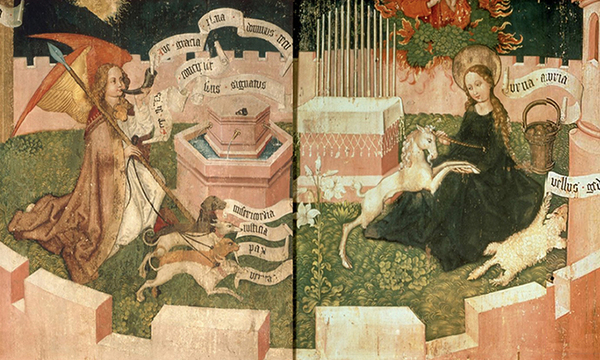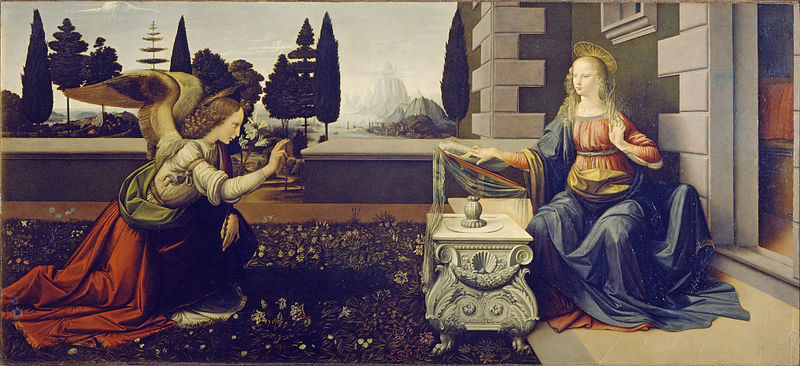The Advent Project: Week 1Намуна

Dec. 4: The Virgin: A Locked Garden

Altarpiece of the Dominicans: The Mystical Hunt. Martin Schongauer, c. 1480. Oil on pine, 116 x 116 cm. (each panel). Musée d' Unterlinden, Colmar, France. Public domain.

The Annunciation, Leonardo Da Vinci, c. 1472–1476. Oil and tempera on wood, 98 × 217 cm.
Uffizi Museum of Art, Florence, Italy. Public domain.
“There Is No Rose of Such Virtue” from the album Awaken Our Souls O God of Hope by the Manitou Singers. Anonymous Fifteenth-Century English Carol arranged by Z. Randall Stroope.
Poetry:
“Pomegranates”
by Shim Hum
translated by Graeme Wilson
It rained last night. The pomegranates,
Red and orange-red,
Have all burst open into flower.
Not to be comforted,
I sit in this cool pavilion
Set in a lotus lake
And under its glass-bead curtains wait
For my closed heart to break.
THE LOCKED GARDEN
A prevailing relational image of God in the Old Testament, alongside the parental “Father,” is that of “Lover” (Philip Yancey uses the phrase “Jilted Lover” to describe a common relational image that emerges in the prophets). As Adam and Eve rejected their cool-of-the evening intimacy with God in the Garden of Eden, they were (and we are) cursed with broken relationships on all sides. Humans spurned God’s loving embrace. Shockingly, God then pursues his lost, unfaithful lovers across the pages of the Old Testament. This relentless pursuit, in which God will go to any length to redeem, purify, and reclaim his beloved, embodies itself in the Incarnation. The Holy Spirit is now at work in the world through the power of Christ, calling and purifying His Bride, the church. All of this will culminate in the Marriage Supper of the Lamb. The pursuit of the Lover is the central drama of the Bible.
The Annunciation, an uncanny microcosm of this drama, and a scene almost unbelievably layered with symbolic meaning, became a core subject within the canon of Christian art. As depictions of the Annunciation developed over time, the garden became a common setting. Through the depiction of Gabriel and Mary in elaborate, walled garden spaces, artists created visual theological commentary. These images collapse Eden, the “locked garden” image from the Song of Solomon, and Gabriel’s announcement to Mary into dense pictures. Mary is the “garden enclosed,” a reference to her virginity, and now her womb will become the enclosed garden where God will take on flesh, and grow in the natural, intimate, dependent way each human must. Mary is stunningly receptive to the Lover, reversing the pattern of unfaithfulness and the rejection of God which has broken Shalom.
The two works provided for reflection today were created in differing styles in the late 15th century. Each presents the Annunciation occurring in a garden setting.The Altarpiece of the Dominicans presents the scene in an intimate garden surrounded by medieval castle walls. As viewers we are also separated from the space by a wall in the foreground. We peer over this fortification to view a scene full of wonders and medieval symbolism. This painting depicts the Annunciation as a supernatural event, full of exotic imagery.
Da Vinci’sAnnunciation moves the event out of medieval space and closer to our world, as Gabriel interrupts Mary’s reading in an environment that suggests a palace garden. Fully utilizing the advances of linear perspective, combined with his mastery of oil paint, Da Vinci creates a deep atmospheric space complete with mountains in the distance. Rather than being fortified against the outside world, this garden seems to extend outward infinitely to the horizon, spilling outward over its low walls. The Incarnation will not only be for Mary. Emerging from her womb, love and salvation will fill the whole earth.
I confess, it is often more comfortable (if less comforting) to think about God, and even Jesus, in more remote, authoritarian terms. As a painter I ponder God as Creator often. Understanding Him as Lover is more challenging. His longing, His jealousy, His relentless pursuit, are mostly too much for my own heart to hold. When He came to Mary, she gave all in response––all she had kept safe and sacred––that which was most precious. My own response should be no less.
Prayer:
Lord Jesus, as we move together through Advent.
Reveal yourself anew as the Lover who comes to us gently
Bringing everlasting delight.
Holy Spirit, claim all that is most precious to us.
Make in us something beautiful, something new.
Amen.
Jonathan Puls, M.F.A., M.A.
Chair of the Art Department
Associate Professor of Art History and Painting
Biola University
For more information about the artwork, music, and poetry selected for this day, please visit our website via the link in our bio.
About this Plan

Biola University's Center for Christianity, Culture & the Arts is pleased to share the annual Advent Project, a daily devotional series celebrating the beauty and meaning of the Advent season through art, music, poetry, prayer, Scripture, and written devotions. The project starts on the first day of Advent and continues through Epiphany. Our goal is to help individuals quiet their hearts and enter into a daily routine of worship and reflection during this meaningful but often hectic season. Our prayer is that the project will help ground you in the unsurpassable beauty, mystery, and miracle of the Word made flesh.
More
Нақшаҳои марбут ба мавзӯъ

The Birth of Jesus

Touched by Grace - the Healing Miracles of Jesus

Born to Save: The Christmas Story of Jesus

NT25 FAST

21 Days: Commissioned

SENT OUT - Embracing Your God-Given Purpose

Reading With the People of God #9 - Faithfulness

Protect Your Peace

The Book of Revelation Decoded
